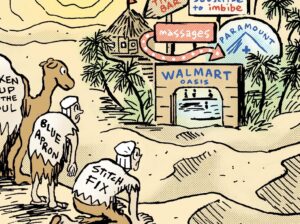Here’s today’s AdExchanger.com news round-up… Want it by email? Sign up here.
Revving The Driverless Revolution
In 2024, self-driving cars emerged from the Trough of Disillusionment, to cite the Gartner Hype Cycle, and leapfrogged the Slope of Enlightenment onto the Plateau of Productivity.
Forgive us the jargon.
Practically speaking, Waymo now completes more than 150,000 rides per week in San Francisco, Phoenix, Austin and Los Angeles, The Ringer reports. Waymo also projects to deliver more than 10 million driverless rides next year.
The Ringer story mostly focuses on how driverless car technology works and its potential to help manage city congestion and reduce traffic accidents.
But the driverless car revolution, if it is coming soon, also has major implications for media and advertising. Today, playing shows, movies, games (and ads) in a car is complicated, because the main in-car screen is located at the front and to the right of the driver – a constant distraction from the road.
In a safe, driverless vehicle, however, whether it’s a rideshare or someone’s personal automobile, there’s the opportunity to claim this untouched wilderness of consumer attention and time with potentially very lucrative ad inventory.
Ask Your Doctor
After more than 15 years of writing and rewriting, the Food and Drug Administration (FDA) has finally made an update to its advertising guidelines for drug manufacturers, Associated Press reports.
The new rules require that TV and radio ads present major side effects in “a clear, conspicuous and neutral manner” – something pharmaceutical companies have already started doing since the FDA was given more authority over ad enforcement in 2007.
But the FDA’s guidelines still don’t account for the kind of content made by paid social media influencers and telehealth companies, because neither actually makes the drugs being advertised.
Nor will anything likely change when it comes to the rather cheesy imagery that’s often used in drug ads (which is good news for people who love “Saturday Night Live” commercial parodies, at least).
It all might be moot anyway, though, if the incoming administration has its way. Robert F Kennedy Jr., who was just announced as President-elect Donald Trump’s pick for Health and Human Services Secretary, made banning pharmaceutical ads a big talking point during his own third-party presidential bid.
Ironically, it might be the one thing that Kennedy and actual health advocates have in common.
Original Artwork, Do Not Steal
In a perfect world, fans and detractors of generative AI would at least be able to agree on one thing: that a living artist’s work shouldn’t be used to train generative AI models if the artist doesn’t want it to be. Right?
And yet, a spokesperson for OpenAI told MIT Technology Review that Glaze and Nightshade, two programs developed by computer scientists at the University of Chicago to combat surreptitious AI scraping, constitute a “type of abuse.”
Both tools add a protective, invisible-to-the-eye layer of data on top of a digital image. With Glaze, AI models will not be able to reproduce images similar to the original, while Nightshade tricks the AI model into producing something different (i.e., a dog instead of a cat), deliberately undercutting the model’s output.
Many AI companies allow artists to opt out these days, but the process is onerous – in OpenAI’s case, each image has to be submitted one at a time – and hard to enforce.
By contrast, Nightshade is like “putting hot sauce on your lunch so it doesn’t get stolen from the workplace fridge,” project leader Ben Zhao told TechCrunch earlier this year. Which sounds a lot less like abuse and more like consequences, to be honest.
But Wait! There’s More!
Google appears to be testing a new AI chat feature for ecommerce searches that serves up AI-based product results based on chat sessions. [Search Engine Roundtable]
Google is also testing removing news articles from search in the EU, a move that’s already backfiring in France. [TechCrunch]
The EU fined Meta $840 million for breaking competition law by using its advertising dominance to boost Facebook Marketplace and restrict ecommerce competitors. [NYT]
In other Facebook news, the platform is changing its primary content performance metric to “views.” [The Verge]
A judge has (temporarily!) halted The Onion’s takeover of Infowars. [Variety]
Droga5 New York lays off 4% of its staff. [Adweek]
You’re Hired
Brad Spychalski joins Fetch as the company’s first VP of creative strategy and partnerships. [LinkedIn]
Eyeo hires former Microsoft Advertising exec Rob Bailey-Adamson as managing director of media. [release]















